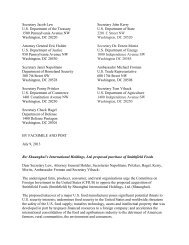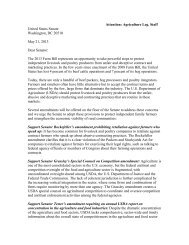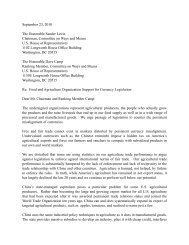Exhibit 8, 100416 Brazil FMD Risk Evaluation - R-Calf
Exhibit 8, 100416 Brazil FMD Risk Evaluation - R-Calf
Exhibit 8, 100416 Brazil FMD Risk Evaluation - R-Calf
You also want an ePaper? Increase the reach of your titles
YUMPU automatically turns print PDFs into web optimized ePapers that Google loves.
Annex 3. Hazard Identification: Swine Vesicular Disease Virus<br />
SVD is a contagious and economically damaging disease of domestic swine and wild boar. The<br />
disease has historically been recorded in Hong Kong, Japan, and several European countries;<br />
however, in 2004 the disease was primarily limited to Italy and Portugal (OIE 2005a). The SVD<br />
virus belongs to the family Picornaviridae, genus Enterovirus [62]. SVD virus is particularly hardy,<br />
as it is resistant to pH changes between 2.5 and 12 and is very stable under cold conditions [76, 77].<br />
The virus is therefore unlikely to be destroyed by the postmortem decrease in muscle pH that<br />
accompanies carcass maturation. SVD virus is also resistant to fermentation and smoking. It may<br />
remain in hams for 180 days, sausages for over a year, and processed intestinal casings for over 2<br />
years [29].<br />
The incubation period for SVD is 2 to 7 days. The intestinal tract is the primary site of infection;<br />
however, all tissues contain virus during the viremic period. Blood and feces of sick animals, as<br />
well as epithelium from vesicles and vesicular fluid, are significant sources of virus. Although SVD<br />
virus does not appear to have a tropism for skeletal muscle cells, it is easily isolated from muscle<br />
tissue from infected animals after slaughter and bleeding out. SVD may be introduced into a herd by<br />
feeding garbage containing infected meat scraps, by introducing infected animals into a herd, or by<br />
contacting infected feces (e.g., an improperly cleaned truck). After the initial introduction the<br />
disease spreads through contact of susceptible pigs with infected pigs and infected feces.<br />
The clinical signs of SVD are easily confused with those of <strong>FMD</strong> and include fever, sudden<br />
lameness, and vesicles with subsequent erosions along the snout, feet, and teats. Morbidity rates<br />
may be low throughout a whole herd but high in certain pens. SVD causes essentially no mortality,<br />
and recovery usually occurs within 1 week (in some cases, up to 3 weeks). SVD infections seldom<br />
persist (Lin et al 2001); however, some strains produce only mild clinical symptoms or are<br />
asymptomatic, and are detected only through laboratory surveillance [29]. For example, a 2002<br />
outbreak of SVD in Italy involved subclinical infection in all but one of 10,312 affected pigs<br />
(Brocchio et al 2002).<br />
APHIS <strong>Evaluation</strong> of the Status of the <strong>Brazil</strong>ian State of Santa Catarina 75











